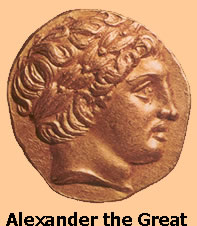 Highlights of the finds from
the site of Pella, which were found from the north part of three rectangular blocks, include (Block 1) the House of the Lion
Hunt, a late 4th century BC building, 50 meters by more than 90meters, with three open courts running north and south. Of its dozen
rooms, three were decorated with mosaics (now in the museum). Also found were fragments of painted plaster, bronze bosses from the doors,
terracotta antefixes, and stamped roof tiles, the latter suggesting some official function for this building. Broad streets with clay water pipes
and stone sewers border it.
Highlights of the finds from
the site of Pella, which were found from the north part of three rectangular blocks, include (Block 1) the House of the Lion
Hunt, a late 4th century BC building, 50 meters by more than 90meters, with three open courts running north and south. Of its dozen
rooms, three were decorated with mosaics (now in the museum). Also found were fragments of painted plaster, bronze bosses from the doors,
terracotta antefixes, and stamped roof tiles, the latter suggesting some official function for this building. Broad streets with clay water pipes
and stone sewers border it.
The central peristyle (six columns square) has been re-erected as well as the large pebble mosaics of the main rooms. In Block 5 more mosaics were found, including 'The Rape of Helen', and 'Stag Hunt'. To the northeast of the main site is the large agora (marketplace), 60,000 square meters in size and surrounded by Doric porticoes, with shops and workshops behind it the huge square. On its north side was a Temple of Aphrodite and Cybele. The main street of the town went through it, with a monumental gateway at the east. To the northwest is a circular Sanctuary of Demeter and Kore, with an altar at its center. To the north of the site (which is fenced) is the Acropolis , with a large complex on it which is being investigated, and which might be a palace. The theater where Euripides play had its first performance, in 408BC, has not been found. The site is open April-Oct Mon noon-7pm;Tues-Sun 8am-7pm; closes 3pm rest of the year; 6euros combined ticket with museum.
 The museum at Pella
The museum at Pella The most interesting exhibits are the mosaic pavements, of which the most stunning show Dionysos on a panther (the favorite animal of the god), a lion hunt, a stag hunt, the Rape of Helen by Paris and his friends Forvas and Theseus, a fight between a Greek and an Amazon, and a griffin attacking a deer.
These mosaics were masterfully done, with pebbles carefully chosen for their soft hues, and arranged in such a way as to create a flow of movement that is very lifelike. Special features are outlined with strips of lead or clay. The eyes, which are missing, were probably semi-precious stones. The grave finds from the two local necropolises, terracotta figurines from the Sanctuary of Aphrodite and Cybele, a collection of late Classical/early Hellenistic coins and metal door fittings (knockers, pivots, keys).